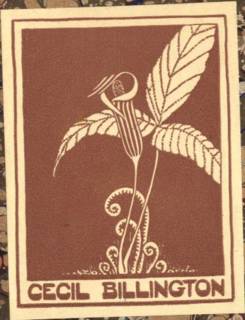I want to acknowledge Ed Cobb and Professor William Crepet at Cornell University for their expertise and assistance in identifying the plants depicted.
Professor Crepet recognized the Ceropegia in Arthur Allman Bullock's plate. He is associated with this genus; his first asclepiad paper was the publication of the East African species Ceropegia filicalyx (1933). He dealt with the entire genus in the 1955 Kew Bulletin. My "thank you" to Dr. Peter Bruyns who has identified the spiecies as C. stapeliiformis.
Ed observes jack-in-the-pulpit (Arisaema triphyllum) with some fern crosiers at the bottom on Billington's.
If you can translate the Naxi hieroglyphs on Professor Rock's, please let me know. The central Chinese characters translate simply to "Dr. (in the Ph.D. sense) Rock; his stamp". They are embossed and palpable on the surface of the paper.
Probably Yosemite with Sequoia gigantea on Harvey Hall's, who, with wife Carlotta, wrote A Yosemite Flora (1912).
Plants on Bessey's plates are a bit more stylized and generalized, but good suggested bets (by Ed Cobb again) are as follows: At eleven o'clock position -Robinia ?pseudoacacia (black locust); At one o'clock position - Gleditsia tricanthos (honey locust); At five o'clock position - Carya laciniosa (shellbark hickory); At seven o'clock position - Aristolochia macrophylla (Dutchman's pipe); At nine o'clock position- Fagus grandifolia (American beech). I don't find that Bessey had any special interest or publications on these, but if you have further suggestions please email me!






Hugo De Vries

No comments:
Post a Comment